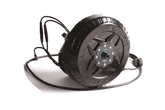Batteries, Charging & Range
Fuses
Tab Welding
Chargers
Recycling
Working out Range
In addition to the ‘amp hour’ storage capacity of your battery, the distance you will get depends on a lot of factors, such as how much you are pedalling, how hilly the terrain is, prevailing wind, how many stop/starts you are doing, the weight of you and the bike, the pressure in your tyres, the age of the battery, and the temperature of the battery. To get the most distance, you should pedal as much as possible, keep your tyres nice and full of air, keep the battery as temperate as possible, avoid stop-starts, and keep your bike well serviced to avoid excess resistance. To get an idea of the time you can ride for on a charge, we can do some basic electrical maths, helped by the WVA Triangle!
So, a 36v 10ah battery should give 360 watt hours, and if you are riding at 200watts, this will last for under 2 hours. Keep in mind there will also be some left-over power that the battery won’t use, to preserve itself. So you might want to presume about 1.5 hours of riding without pedalling. If we presume we are applying an equal amount of power as the motor through pedalling, we can double this, which should get the average person about 3 hours per charge, or somewhere around 60kms at an average speed of 20km/h (on the flat).
If you need to use two batteries we have a specially designed and manufactured Dual Battery Unit which allows two batteries to be used either consecutively or at the same time. Ideal for those longer trips, allowing you to venture much further from home.
Battery Care
The biggest problem by far is in users not being taught how to properly care for their packs. Many suppliers don’t provide any instructions, or people don’t read them. We’ve encountered lithium batteries which have been left on to “trickle charge” – not desirable! Or putting the charger on a timer, to run for 2 hours per day… this is like a kick in the guts to an already full pack. Or the opposite, being left for extended periods like 2 years, without a single charge. There are several important factors which determine how long your pack will last. Here are a few Golden Rules which are helpful to remember:
1. Always turn the battery/motor OFF when you are not using it (like locking your car when you get out)
2. Charge up your battery to 90% rather than 100% as often as possible, and avoid running right down to totally empty
3. Keep it out of extreme heat (over 30 degrees) or cold (below 5 degrees)
4. If not using it for a while, store it at half charge. Push some charge into the battery every 3 months.
5. When out riding, if your pack is so low that the controller cuts power, be sure to limp home with minimal or no assistance, rather than continuing to squeeze every last drop out of the pack.
Caring for your battery will give it a good long life, and you will save yourself HUNDREDS of dollars, and much frustration, by looking after it properly. The peace of mind you’ll enjoy from a quality pack will help you sleep at night, especially when it’s on charge in your garage!
- Choosing a selection results in a full page refresh.
















